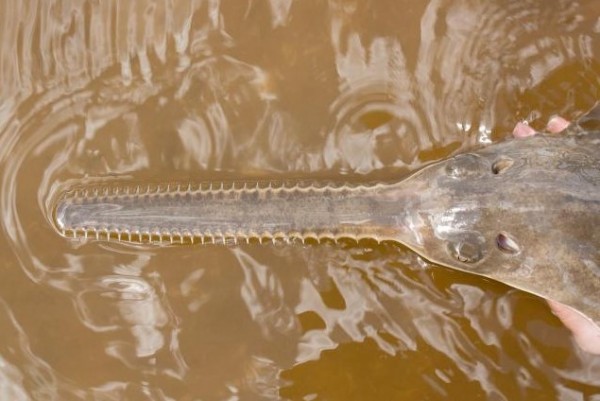'Virgin Births' Happen To Smalltooth Sawfish As They Face Extinction; What Caused Asexual Reproduction?
| Althea Serad | | Jun 03, 2015 03:30 AM EDT |
(Photo : Reuters) A juvenile smalltooth sawfish is pictured in the Charlotte Harbor estuarine system in Florida in this undated handout photo obtained by Reuters June 1, 2015.
The smalltooth sawfish are facing extinction, but they are fighting to survive according to a research published in the journal Current Biology on June 1.
They may be endangered, but scientists found that a species of critically endangered sawfish in the wild have resorted to reproducing through "virgin births" to curb their extinction, which is a result of overfishing and the destruction of their habitat, according to ioL SciTech.
Like Us on Facebook
The asexual reproduction of the smalltooth sawfish in Florida witnessed by the scientists is reportedly the first solid evidence they have seen for any backboned animal in the wild.
In "virgin births," or parthenogenesis, scientists explain that female egg cells are able to mature into a baby without the help of fertilization from a male sperm cell. The egg instead absorbs a cell genetically identical, thus transforming into an offspring half as diverse as its mother.
Parthenogenesis is not unknown to some species, but offspring from "virgin births" do not usually survive.
Amazingly, the sawfish discovered by the study's researchers were not only found to be viable, but they are reportedly perfectly healthy. These sawfish were tagged and then later released into the wild.
The scientists were originally conducting a research on sawfish inbreeding, and that is when they chanced upon seven healthy offspring all born through parthenogenesis. They examined 3 percent of the seven sawfish.
On Monday, the scientists told Current Biology that the discovery is the first time that parthenogenesis has been seen on a vertebrate in the wild. They added that the females could have resorted to such a method since the species' numbers have been so low that there is also low mating opportunities.
"There have been a number of cases in reptiles, birds and sharks of 'virgin birth' in captivity," according to Andrew Fields, a marine biologist at Stony Brook University. "This raises many questions about how common this mode of reproduction is in the wild."
The smalltooth sawfish live for around three years in southwest Florida estuaries after they are born. They eventually move on to ocean coastal habitats over time.
In most of the Atlantic, the species cannot be found already. This comes as a shock as just a century ago, they are common inhabitants in the region, reported Live Science.
The depletion in the number of smalltooth sawfish is reportedly the result of habitat loss, "unintentional" overfishing, or simply getting caught in nets meant for other fish. In 2003, they were given US federal endangered species protection.
There are five species of sawfish, and all are classified endangered or critically endangered. According to The Washington Post, they could be the first marine animals to go extinct in the near future.
"It really surprised us," said Kevin Feldheim, manager of the Pritzker Laboratory for Molecular Systematics and Evolution at Chicago's Field Museum. "It is possible that numbers are so low that females have a hard time finding mates. In such a situation, parthenogenesis can be used as a last-ditch effort for a female to pass on her genes."
Though the smalltooth sawfish have been found capable of "virgin births" or parthenogenesis, this ability is not enough to save them from going extinct.
Feldheim said the current findings should instead hasten efforts of saving the species before it becomes too late.
"Parthenogenesis could help endangered species like sawfish dodge extinction for a little while, but it should also serve as a wake-up call that we need serious global efforts to save these animals," Feldheim said.
Tagsfemale sawfish virgin births, female sawfish, virgin births, female sawfish florida, asexual reproduction, current biology journal, smalltooth sawfish, smalltooth sawfish virgin births, parthogenesis
©2015 Chinatopix All rights reserved. Do not reproduce without permission
EDITOR'S PICKS
-

Did the Trump administration just announce plans for a trade war with ‘hostile’ China and Russia?
-

US Senate passes Taiwan travel bill slammed by China
-

As Yan Sihong’s family grieves, here are other Chinese students who went missing abroad. Some have never been found
-

Beijing blasts Western critics who ‘smear China’ with the term sharp power
-

China Envoy Seeks to Defuse Tensions With U.S. as a Trade War Brews
-

Singapore's Deputy PM Provides Bitcoin Vote of Confidence Amid China's Blanket Bans
-

China warns investors over risks in overseas virtual currency trading
-

Chinese government most trustworthy: survey
-

Kashima Antlers On Course For Back-To-Back Titles
MOST POPULAR
LATEST NEWS
Zhou Yongkang: China's Former Security Chief Sentenced to Life in Prison

China's former Chief of the Ministry of Public Security, Zhou Yongkang, has been given a life sentence after he was found guilty of abusing his office, bribery and deliberately ... Full Article
TRENDING STORY

China Pork Prices Expected to Stabilize As The Supplies Recover

Elephone P9000 Smartphone is now on Sale on Amazon India

There's a Big Chance Cliffhangers Won't Still Be Resolved When Grey's Anatomy Season 13 Returns

Supreme Court Ruled on Samsung vs Apple Dispute for Patent Infringement

Microsoft Surface Pro 5 Rumors and Release Date: What is the Latest?










